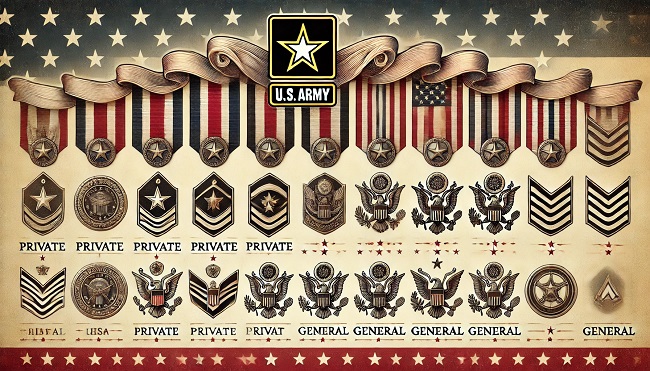Navigating the hierarchy of the U.S. Army Ranks can be a formidable task, especially for those unfamiliar with military structures. This guide aims to demystify the U.S. Army ranks in order, providing insights into the roles and responsibilities that come with each rank, from the lowest to the highest. Our exploration is not only aimed at enhancing understanding but also at highlighting the progression and pay scales associated with each position, without affiliating with any specific brand or entity.
The Structure of U.S. Army Ranks
The U.S. Army’s structure is broadly divided into two categories: enlisted ranks and officer ranks. The enlisted ranks begin with the most junior personnel, commonly known as Privates, and ascend to the senior enlisted advisor positions. On the other hand, U.S. Army officer ranks start from Second Lieutenant, typically a platoon leader, to the General of the Army, a rank that is held during wartime.
Enlisted Ranks Explained
The journey through the enlisted ranks starts with the Private (E-1), the entry-level position often occupied by new recruits. As they gain experience and prove their mettle, they can ascend through several ranks, such as Private First Class (E-3) and Specialist (E-4), each offering different responsibilities and pay grades. The pinnacle of the enlisted pathway is the Sergeant Major of the Army, a rank that represents the top enlisted advisor to the Army Chief of Staff.
Officer Ranks and Their Significance
U.S. Army officer ranks signify increased levels of authority and responsibility. Starting as a Second Lieutenant (O-1), officers get direct leadership roles, which expand as they climb up to ranks like Captain (O-3) and Major (O-4). Each rank not only demands a greater level of expertise and leadership but also brings higher pay and more significant benefits. The highest officer rank during peacetime is General (O-10), a rank held by those who lead major army divisions or the entire army in some cases.
Comparison with U.S. Marine Ranks
While discussing the U.S. Army ranks, it’s interesting to compare them with U.S. Marine ranks. Both follow a similar structure with their own unique titles and roles, reflecting each service’s distinct culture and operational focus. For instance, while the Army has Sergeants, the Marines have Gunnery Sergeants, a rank that comes with its own set of duties and history.
Enlisted Ranks
Enlisted soldiers form the core of the Army, possessing specialized skills within their respective units. They carry out designated roles and possess the expertise necessary to achieve their unit’s objectives, thereby ensuring the success of ongoing missions within the Army.
Army Ranks and Pay: A Closer Look
One of the most common questions regarding Army ranks and pay concerns the financial benefits associated with each rank. As expected, pay increases with rank, with officers generally earning more than enlisted personnel. This pay structure is designed to compensate for the increased responsibilities and skill levels associated with higher ranks.
What are the 13 Ranks in the Army?
When asked, «what are the 13 ranks in the army?» it’s important to clarify that the U.S. Army has more than 13 ranks when combining enlisted and officer ranks. However, focusing on enlisted ranks alone, there are exactly 13, starting from Private (E-1) to Sergeant Major of the Army (E-9).
Conclusion
The U.S. Army’s ranking system is designed to create a streamlined chain of command and ensure that each member is adequately trained and compensated for their roles. Whether you’re a military enthusiast, a potential recruit, or simply curious about military hierarchy, understanding these ranks provides valuable insights into how one of the world’s most powerful armies operates.
FAQs
- What are the entry-level U.S. Army ranks?
- The entry-level rank in the U.S. Army is Private (E-1).
- How do U.S. Army officer ranks differ from enlisted ranks?
- Officer ranks involve leadership from the beginning and require a college degree or higher; enlisted ranks do not initially require a degree and focus on specific technical skills and support roles.
- What is the highest rank in the U.S. Army during peacetime?
- The highest rank during peacetime is General (O-10).
- How does the pay structure vary across different Army ranks?
- Pay increases with rank and years of service, with officers generally earning more than enlisted personnel.
- Are U.S. Army ranks and U.S. Marine ranks the same?
- While similar, the ranks have different titles and roles reflecting each service’s unique structure and culture.













